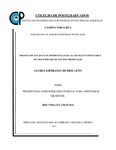| dc.description.abstract | El objetivo del presente estudio fue estimar la producción de biomasa, requerimiento interno y demanda de nitrógeno, fósforo y potasio en dos especies de pastos tropicales: Humidícola (Brachiaria humidicola) y Taiwán (Pennisetum purpureum), mediante la metodología del modelo de balance nutrimental. Se usó un diseño completamente al azar con arreglo factorial, evaluando los factores: época climática, nivel de fertilización y frecuencias de corte. Se observaron diferencias significativas dentro de los factores evaluados; en pasto Humidícola el mayor requerimiento interno de nitrógeno (RIN) se observó en Nortes, con la dosis alta (DA) y a los 20 días de rebrote con 1.60, 1.56 y 1.50%, respectivamente. El mayor rendimiento de biomasa seca (RBS) se observó en Lluvias, con la DA de fertilización y a los 30 días de rebrote con 9.2, 8.1 y 7.7 t ha-1, respectivamente; el mejor contenido de proteína cruda (PC) se observó en Nortes, en la DA y a los 20 d de rebrote con 10.0, 9.8 y 9.4%, respectivamente. Las mayores demandas de nitrógeno (DEMN) se encontraron en la época Seca y de Lluvias con 144 y 143 kg ha-1, respectivamente y en la DA (158 kg ha-1). Las mayores demandas de fósforo (DEMP) se observaron en Seca y Lluvias con 20 y 22 kg ha-1 y de potasio (DEMK) se encontraron en Lluvias, en la dosis normal (DN), DA y a los 30 d de rebrote con 106, 81, 90 y 95 kg ha-1, respectivamente. En pasto Taiwán el mayor requerimiento interno de fósforo (RIP) fue observado en la DA y a los 40 d de rebrote (1.71 y 1.86%, respectivamente); el mejor RBS se observó en época Seca, con las DN y DA y a los 80 d de rebrote con 6.4, 5.2, 4.6 y 7.2 t ha-1, respectivamente. La DEMN se observó mayor en Seca, con las DN, DA y a los 80 días de rebrote con 90, 75, 72 y 88 kg ha-1, respectivamente; las mayores DEMP fueron observadas en Seca, con la DA y a los 80 días de rebrote (12, 11 y 12 kg ha-1, respectivamente) y la DEMK superior fue observada en época Seca, con las DN, DA y a los 80 días de rebrote del pasto con 99, 82, 73 y 105 kg ha-1, respectivamente; y el mayor contenido de PC fue de 11.9 y 11.9% con la DA y a los 40 días de rebrote, respectivamente. _______________ NUTRIMENTAL BALANCE MODEL FOR THE SUSTAINABLE MANAGEMENT OF TWO SPECIES OF TROPICAL PASTURES. ABSTRACT: The objective of the present study was to estimate the biomass production, internal requirement and demand for nitrogen, phosphorus and potassium in two tropicals pasture species: Humidícola (Brachiaria humidicola) and Taiwán (Pennisetum purpureum), using the nutrient balance model methodology. A completely randomized design with factorial arrangement was used, evaluating the factors: climatic season, fertilization level and cutting frequencies. Significant differences were observed within the factors evaluated; in humidícola pasture the higher nitrogen internal requirement (IRN) was observed in North, with the high dose (HD) and at 20 days of regrowth with 1.60, 1.56 and 1.50%, respectively. The best dry biomass yield (DBY) was observed in Rainy, with HD of fertilization and at 30 days of regrowth with 9.2, 8.1 and 7.7 t ha-1, respectively; the best raw protein content (CP) was observed in North, in the HD and at 20 days of regrowth with 10.0, 9.8 and 9.4%, respectively. The highest nitrogen demands (NDEM) were found in Dry and Rainy season with 144 and 143 kg ha-1, respectively and in the HD (158 kg ha-1). The greatest potassium demands (PDEM) was observed in Drought and Rainfall with 20 and 22 kg ha-1 and potassium (KDEM) were found in Rains at normal doses (ND), HD and at 30 days of regrowth with 106, 81, 90 and 95 kg ha-1, respectively. In Taiwan grass, the highest phosphorus internal requirement (IRP) was observed in HD and 40 d of regrowth (1.71 and 1.86%, respectively); the best DBY was observed in the dry season, with the ND and HD and the 80 d of regrowth with 6.4, 5.2, 4.6 and 7.2 t ha-1, respectively. The NDEM was observed higher in Drought, with ND, HD and 80 d of regrowth with 90, 75, 72 and 88 kg ha-1, respectively, the highest PDEM were observed in Drought, with HD and 80 days of regrowth (12, 11 and 12 kg ha-1, respectively) and the upper DEMK was observed in dry season, with ND, HD and 80 days of regrowth of pasture with 99, 82, 73 and 105 kg ha-1, respectively; and the higher content of PC was 11.9 and 11.9% with the HD and 40 days of regrowth, respectively. | es_MX |


